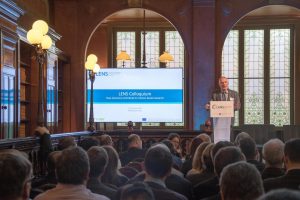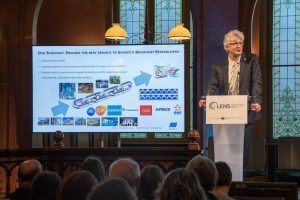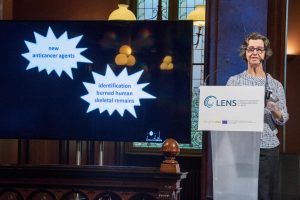Neutrons against cancer and HIV
The European Union has made it clear that research and innovation will focus on missions in the forthcoming Horizon Europe Framework Program. That is, actions with concrete benefits for society in the fields of health, climate, food, energy or digitization. The League of advanced European Neutron Resources (LENS) presented in Brussels the main results of research on neutrons and their benefits for people.
The meeting was held on Tuesday, February 11 in the Bibliothèque Solvay in Brussels and brought together members of Europe’s neutron science community, several European Commission representatives, and representatives from the League of European Accelerator-based Photon Sources (LEAPS)—a consortium of analytical facilities allied with LENS.
“Back in 1927 Brussels was different than today,“ highlighted the historical significance of the location European Spallation Source Director General John Womersley. The most famous conference in the history of physics was held nearby in 1927. The 5th Solvay Conference on Electrons and Photons brought together among others Albert Einstein, Niels Bohr and Marie Sklodowska-Curie.
John Womersley
God does not play dice
“God does not play dice with the universe,” John Womersley cited Einstein’s famous quote. He stressed that the research infrastructures need a clear vision how to address societal challenges. His opening was followed by the Director of the ALBA Synchrotron Caterina Biscari who spoke about LEAPS facilities. “We are preparing our position paper for Horizon Europe aiming at showing how our facilities are useful for Horizon Europe´s missions. We have several European projects to develop data management. Photon science needs huge amount of data and we need trained people to be able to work with them,“ said Biscari.
The Director of the Laue-Langevin Institute Helmut Schober compared science to building a house: “When you build a house, you need the best service. It’s a holistic approach,” said Schober. Neutron science explores the world at the atomic and molecular level and thus can contribute e.g., to better targeting anticancer and HIV drugs.
Helmut Schober
The role of neutrons in cancer research
Maria Paula M. Marques from the University of Coimbra, Portugal, focuses on vibrational spectroscopy. Her team uses neutron scattering techniques to study the changes that occur in a cell when it is treated for cancer. Their work focuses on water inside cells and how this intracellular water can be used as a target for anticancer drugs. In 2019, Maria Marques won the ISIS Society Impact Award, which value the neutron spectroscopy for clinical research.
Crossdisciplinary research is a key
“We are always between basic and clinical research. We have to try to develop good drugs but having them in our laboratory is not helping anyone,” said Maria Marques. She was answering a question from the DG Research and Innovation at European Commission representative Adam Tyson during the closing panel asking what she would like to see in neutron science to help her team. “It is difficult to explain to pharmaceutical people what neutron scattering is good for. We would need a biological laboratory next to us. Having a molecular-biology lab would help us a lot. We need new facilities and labs. To be as flexible as possible,“ said Maria Marques.
Maria Marques
The League of advanced European Neutron Sources, LENS, is a not-for-profit consortium working to promote cooperation between European-level neutron infrastructure providers offering transnational user programmes to external researchers.
More information can be found on the https://www.lens-initiative.org/
Prepared by: Vlaďka Coufalová, J. Heyrovsky Institute of Physical Chemistry of the Czech Academy of Sciences
Photo: LENS


